Searching for Baby Planets in a Star’s Dusty Rings
How did our Solar System form? Is it unique? These are age-old questions, but in the last two decades, astronomers have addressed them anew by observing extrasolar planets and the so-called protoplanetary disks of dust and gas that surround young stars. The pace of progress has been remarkable. We now know that extrasolar planets have a much wider range of masses and densities than the planets in our Solar System, and they can migrate far from where they were born. Witnessing the birth of planets in protoplanetary disks has, however, remained stubbornly out of reach. That is now changing. A string of recent studies based on observations with the Atacama Large Millimeter and Submillimeter Array (ALMA) in Chile have seen “gaps” in the dust that are suggestive of the presence of new planets. The latest of these, from an international collaboration of scientists (Isella et al. [1]), observes these gaps in both the dust and the gas, providing the strongest evidence yet for interpreting these gaps as the signatures of new planets.
In the leading theory for planet formation, planets emerge from the coalescence of dust and gas that swirl around a newly formed star. Although such protoplanets are hard to directly image compared to the bright central star, their gravity can have noticeable effects on the dust and gas distributions, creating structures such as rings (excess dust and gas particles) or gaps (missing particles). Protoplanets are expected to affect the gas and dust distributions in different ways because the dust particles settle in a thin layer at the disk's midplane while the gas is more spread out.
ALMA images protoplanetary disks using an array of antennas that detect the electromagnetic emissions of dust and gas at millimeter wavelengths. In the last two years, ultrahigh-resolution ALMA images of disks have revealed both ringed structures and gaps in the dust [2, 3]. These spectacular new images have an angular resolution of 20–30 milliarcseconds—equivalent to the width of a human hair at one mile.
Unfortunately, it’s not clear-cut that the features that have been observed in ALMA images come from planets, because other processes can create them. For example, they could be linked to the condensation or evaporation of dust grains that occur at different distances from the star because of large radial temperature gradients in the disk. Alternatively, they could arise from the concentration of millimeter-sized particles in regions of gas where the turbulence is low or the pressure is high. The work by Isella et al. [1] makes a considerable step towards resolving this ambiguity: They image not only the gaps in the dust of a protoplanetary disk, but also the distribution of gas (specifically, carbon monoxide) across these gaps, thus providing a more detailed description of the physical mechanisms at play.
The researchers imaged a disk that encircles a star roughly twice the mass of our Sun, known as HD 163296. This disk is one of the largest and brightest known, and the gaps between its rings are much wider and more widely separated than those of disks around other recently studied young stars, namely HL Tau [2] and TW Hya [3]. This enabled Isella et al. to collect their images at 10 times lower resolution than in earlier studies, resulting in a stronger signal per image pixel. This lower resolution is crucial to obtaining information about the gas. Specifically, while the signal from dust, which emits over a broad continuum of wavelengths, can be summed to obtain a good signal, the same cannot be done for the gas emission, which occurs in narrow spectral lines.
The resulting images of the continuum emission reveal three clear gaps, but the images of the line emission show a much smoother distribution with subtle variations (Fig. 1). By modeling these data, Isella et al. deduced that there is a gap in the dust at 60 A.U. from the star—1 A.U. is the distance between the Earth and Sun—and it is filled with gas. In contrast, they find two outer gaps at 100 and 160 A.U. that are depleted approximately equally in both dust and gas.
Assuming a planet is the cause of a gap in the dust, Isella et al. infer the planet’s mass from the gap’s width and location. Using hydrodynamic simulations to determine the effect of this mass on the gas, they show that planets with roughly the mass of Saturn (or one third the mass of Jupiter) could carve the inferred dips in both the dust and the gas. This is compelling evidence for new planets, as other processes cannot produce such strong effects on the gas structure.
However, a single planet cannot explain the innermost gap. This is because the smallest planetary mass that could produce a dust gap with the observed width would also noticeably perturb the gas profile. The authors therefore offer two possibilities. One is that there are multiple small planets orbiting within the gap but at different radii. The other option is a pileup of the dust particles that drift radially inward towards the star. This would produce a bright ring of emission on top of the otherwise smooth emission background, thereby creating the appearance of a gap. Such pileups can take place deep in the disk, where turbulent motion dies away. Or they can happen at the carbon monoxide “snow line,’’ the distance from the star at which icy mantles evaporate, causing dust grains to break up. Although the cause of the innermost dust gap remains uncertain, the combination of the gas and dust observations provides a much richer examination of the relevant physics.
The scale of the structures in the HD 163296 disk makes it a compelling target for follow-up work, not only with ALMA but also with infrared telescopes that might be able to directly image the widely separated putative protoplanets. More generally, ALMA’s great sensitivity and high resolution is radically changing our view of the sky at millimeter wavelengths. It’s having a profound impact on our ability to study the origin of galaxies, stars, and planets. The future for protoplanetary disk research is particularly exciting. We will be able to measure the occurrence of rings and other structures in the dust and gas, and study the relationship between these features. Ultimately, we will learn about the conditions for forming planets massive enough to disturb disks, see where they form, and infer how long this takes. In this way we will find out more about the formation of our Solar System and how it compares to others.
This research is published in Physical Review Letters.
References
- A. Isella et al., “Ringed structures of the HD 163296 protoplanetary Disk Revealed by ALMA,” Phys. Rev. Lett. 117, 251101 (2016).
- C. L. Brogan et al., “The 2015 ALMA Long Baseline Campaign: First Results from High Angular Resolution Observations Towards the HL Tau Region,” Astrophys. J. Lett. 808, L3 (2015).
- S. M. Andrews et al., “Ringed Substructure and a Gap at 1 au in the Nearest Protoplanetary Disk,” Astrophys. J. Lett. 820, L40 (2016).





